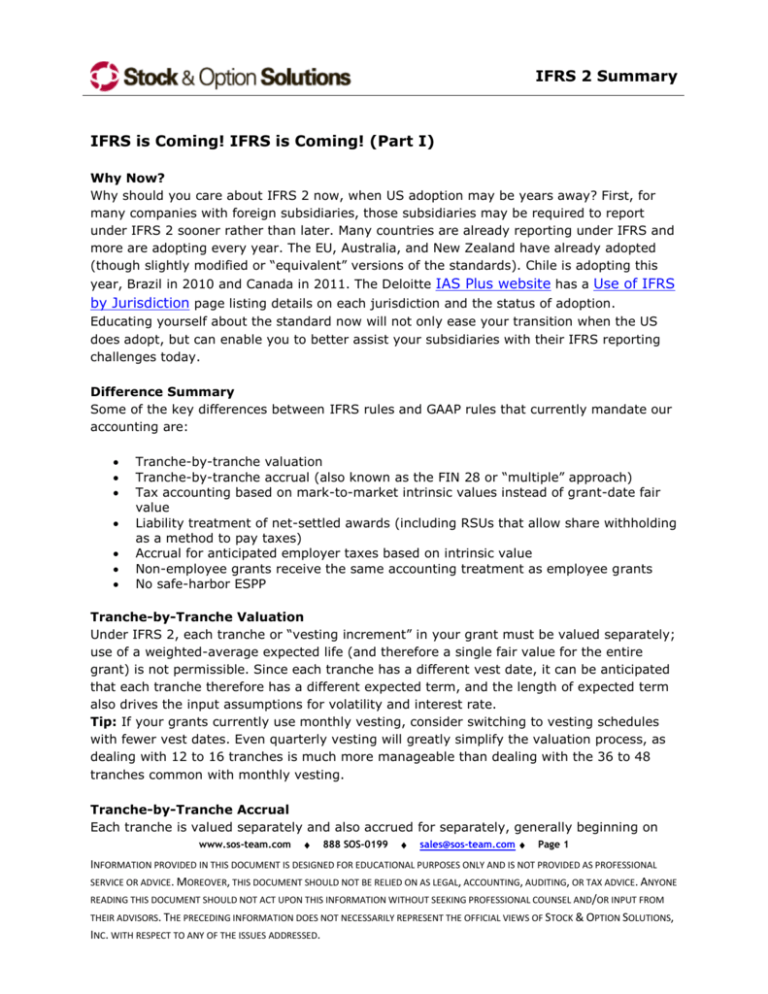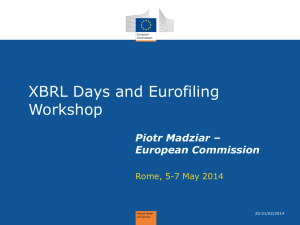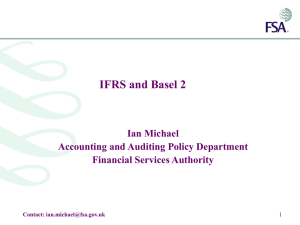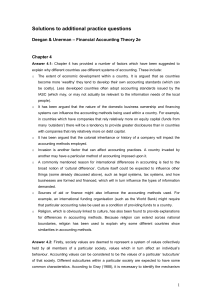Summary of IFRS 2 - Stock & Option Solutions
advertisement

IFRS 2 Summary IFRS is Coming! IFRS is Coming! (Part I) Why Now? Why should you care about IFRS 2 now, when US adoption may be years away? First, for many companies with foreign subsidiaries, those subsidiaries may be required to report under IFRS 2 sooner rather than later. Many countries are already reporting under IFRS and more are adopting every year. The EU, Australia, and New Zealand have already adopted (though slightly modified or “equivalent” versions of the standards). Chile is adopting this year, Brazil in 2010 and Canada in 2011. The Deloitte IAS Plus website has a Use of IFRS by Jurisdiction page listing details on each jurisdiction and the status of adoption. Educating yourself about the standard now will not only ease your transition when the US does adopt, but can enable you to better assist your subsidiaries with their IFRS reporting challenges today. Difference Summary Some of the key differences between IFRS rules and GAAP rules that currently mandate our accounting are: Tranche-by-tranche valuation Tranche-by-tranche accrual (also known as the FIN 28 or “multiple” approach) Tax accounting based on mark-to-market intrinsic values instead of grant-date fair value Liability treatment of net-settled awards (including RSUs that allow share withholding as a method to pay taxes) Accrual for anticipated employer taxes based on intrinsic value Non-employee grants receive the same accounting treatment as employee grants No safe-harbor ESPP Tranche-by-Tranche Valuation Under IFRS 2, each tranche or “vesting increment” in your grant must be valued separately; use of a weighted-average expected life (and therefore a single fair value for the entire grant) is not permissible. Since each tranche has a different vest date, it can be anticipated that each tranche therefore has a different expected term, and the length of expected term also drives the input assumptions for volatility and interest rate. Tip: If your grants currently use monthly vesting, consider switching to vesting schedules with fewer vest dates. Even quarterly vesting will greatly simplify the valuation process, as dealing with 12 to 16 tranches is much more manageable than dealing with the 36 to 48 tranches common with monthly vesting. Tranche-by-Tranche Accrual Each tranche is valued separately and also accrued for separately, generally beginning on www.sos-team.com 888 SOS-0199 sales@sos-team.com Page 1 INFORMATION PROVIDED IN THIS DOCUMENT IS DESIGNED FOR EDUCATIONAL PURPOSES ONLY AND IS NOT PROVIDED AS PROFESSIONAL SERVICE OR ADVICE. MOREOVER, THIS DOCUMENT SHOULD NOT BE RELIED ON AS LEGAL, ACCOUNTING, AUDITING, OR TAX ADVICE. ANYONE READING THIS DOCUMENT SHOULD NOT ACT UPON THIS INFORMATION WITHOUT SEEKING PROFESSIONAL COUNSEL AND/OR INPUT FROM THEIR ADVISORS. THE PRECEDING INFORMATION DOES NOT NECESSARILY REPRESENT THE OFFICIAL VIEWS OF STOCK & OPTION SOLUTIONS, INC. WITH RESPECT TO ANY OF THE ISSUES ADDRESSED. IFRS 2 Summary grant date and ending on the vest date. Straight-line accrual for the entire grant, one of the allowable accrual methods under FAS 123(R), is not acceptable under IFRS 2. This will generally result in “front-loaded” accrual, meaning that more of the expense for the award will be recognized early in the life of the grant, since all the tranches generally begin accruing simultaneously. Tips: Again, considering vesting schedules with fewer vest dates will lessen the amount of “front-loading” of your accruals. However, we also point out that since the accrual begins with a larger amount, but tapers off dramatically over the service period of the grant, if your grant patterns are similar each year, the expense patterns will even out over the first few years of adoption, leaving you with even accrual over time, very similar to straight-line accrual. Another silver lining to this particular issue is that since this was a permissible accrual method under FAS 123(R), many softwares and systems can already support tranche-by-tranche valuation and accrual. Tax Accounting Ellie Kehmeier, of Deloitte Tax LLP, says, “Just when we thought we had the tax accounting finally figured out under FAS 123(R), IFRS2 will introduce many new complexities and challenges for stock administrators, software vendors, and tax departments." Her point is that the tax accounting under IFRS 12 is very different than what we’ve become accustomed to under GAAP, and is likely to cause much more volatility in our income statements, since it is really “mark-to-market” or variable accounting based on the intrinsic value of the awards each quarter. Instead of accruing a deferred tax asset (DTA) based on the grant-date fair value of the grant, you accrue based on the intrinsic value of the grant at the end of the reporting period. However, the Deferred Tax Benefit (DTB) is limited to the cumulative tax benefit recognized to date. Let’s consider an option for 1,000 shares with an $8 price, $5 grantdate fair value and a current market value of $9 and 25% of the vesting period completed. For this option, you’d compare the intrinsic value ($1,000) multiplied by your corporate tax rate (40%) by the percentage of the service period completed (25%) to compute the DTA to book ($100). If in the next quarter the option dropped underwater, you’d reverse the DTA you booked, since the new intrinsic value is $0. Later, when the grant is 100% vested, the market value is $14. The intrinsic value is $6,000. When multiplied by the tax rate (40%) and service period (100%) this would be a $2,400 entry to DTB. But since the DTB is capped by the Cumulative Tax Benefit (expense accrued * tax rate * service period) of $2,000, the DTB would be booked up to $2,000 and the excess of $400 would be posted to Additional Paid-in Capital (APIC). The other big difference under IFRS is that there is no APIC pool available to offset deficiencies, so any deficiencies will go straight to tax expense, impacting your P&L directly, regardless of past excess transactions. The good news is that since the DTA is trued up each quarter to the current market value, the deficiencies are likely to be significantly smaller. Observations: Under FAS 123(R), the booking of DTA was completed once the vesting was complete. Under IFRS, the DTA and DTB true ups will continue until the award is settled. www.sos-team.com 888 SOS-0199 sales@sos-team.com Page 2 IFRS 2 Summary This will likely mean a great deal of manual effort until the stock plan softwares and systems have been updated to handle these true ups. Liability Treatment of Net-Settled Awards Under IFRS, awards that allow payment of taxes via share withholding are subject to liability accounting. This difference could be extremely problematic for many firms with RSUs since a large percentage of those companies allow (or mandate) share withholding as an easy way for participants to pay taxes due at the time shares are delivered (released). In theory this treatment is only required for the portion of the award that is "cash-settled" (the shares due for taxes) but as a practical matter may be necessary for the entire award since the number of shares withheld for taxes will vary as the tax rate varies (common in international jurisdictions where a "flat rate" of withholding is generally not available). Let's consider an example: An RSU for 100 shares is granted when the market value is $10 and allows the participant to choose to have shares withheld to cover the tax liability. At the most recent quarter close the market value of the stock is $25. The tax rate is 40%. The taxes due would therefore be $1,000 ($25*100*40%). Hence 40 shares would be required to cover taxes ($1,000 / $25). So 40 shares should receive liability treatment this quarter and in each subsequent quarter. The shortcut method to derive the number of shares that require liability treatment is to multiply the shares granted by the tax rate. So 60 shares would be expensed at the grant-date market value of $10 and 40 shares would be "marked-to-market" each quarter. Employer Taxes Liability Accrued (Mark-to-Market) Under FAS 123(R), the amount of employer taxes to be paid are determined at the time the taxable event occurs (exercise, vesting, etc.). Under IFRS, as with other liabilities the taxes that must be paid by the employer must be anticipated and a liability accrued for them. Since the amount of employer tax to be paid obviously varies each quarter, depending on the market value of the underlying stock, the liability must be "marked up" and "marked down" with the movement of the market. Essentially this results in "liability accounting" for the employer portion of the payroll taxes. The calculations are the same as they would be for grants that receive liability treatment, but then the calculated gain is multiplied by the applicable employer tax rate. This calculation becomes even more complicated when you consider that there are sometimes caps on the employer taxes (such as FICA); the mark-to-market calculations cannot be performed in a vacuum. The YTD wages for the employee must be known and used to determine the amount of tax remaining to be withheld. If the employee holds several outstanding grants, the hypothetical gain on the other awards must also be considered when computing this liability. Theoretically a first-in-first out (FIFO) approach could be used, counting the hypothetical gain from the oldest grant against the limit before moving to the next oldest grant, but applying a FIFO methodology comes with its own share www.sos-team.com 888 SOS-0199 sales@sos-team.com Page 3 IFRS 2 Summary of headaches since the grants must be related to one another before the calculations can be performed. Non-Employee Grants The silver lining of IFRS 2 may be the treatment of non-employee grants. Non-employee grants receive the same equity treatment as employee grants. As you're probably aware, under FAS 123 and FAS 123(R) the accounting treatment of non-employee grants was governed by EITF 96-18 which required recalculation of the fair value of the grant at each reporting period up until the grant vested. Treatment is complicated further should an employee's status change and the grant is retained in that the accounting treatment must also change, prospectively. Under IFRS, none of these complications exist and changes of employee status will be accounted for much more simply. No Safe-Harbor ESPP Under FAS 123(R) section-423 qualified ESPPs could be considered non-compensatory (and therefore did not require the booking of compensation expense) as long as the discount on the ESPP did not exceed 5% and there was no lookback. For those companies that adopted "safe-harbor" plans in an effort to avoid compensation expense, they may now consider eliminating their ESPP all together. However, since participation rates generally dropped sharply when plans were modified to meet the safe-harbor requirements, hopefully this will not impact too many employees. Many companies kept their ESPPs intact with a 15% discount and a 6- to 24-month lookback. This change will obviously not impact those companies. If you have questions on any portion of this article, please e-mail us at: xtra@sosteam.com. About Stock & Option Solutions Stock & Option Solutions is a leading provider of top-tier stock plan management and consulting services for companies offering equity compensation and benefit programs to its employees. For ten years, hundreds of organizations, from private start-ups to Fortune 500 companies, have relied on Stock & Option Solutions’ expertise for strategic planning, methodologies and skilled resources to build and support the most effective stock plan programs possible. For more information about our products or services, please contact us at: sales@sos-team.com 888 SOS-0199 (888 767-0199) www.sos-team.com 888 SOS-0199 sales@sos-team.com Page 4





